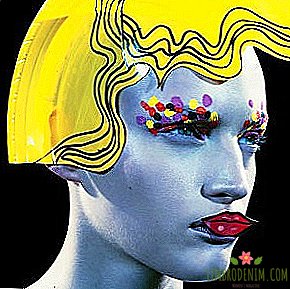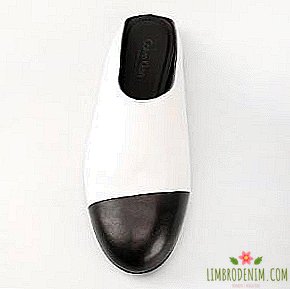Ruches and everything transparent: 10 non-romantic Russian stamps
Genre of intellectual romance He diversified the collections of Russian designers immediately after the interest in minimalism began to decline - this is noticeable at least by the fact that many young brands who chose to work with this style appeared at about the same time, two or three years ago. We tell about the most remarkable.
LES '
Lesa Paramonova can rightly be considered the pioneer of neo-romanticism, her brand has been around for more than five years. The first collections Lesya sewed on her own, and she herself took off the lookbooks on a smartphone (before everyone began to do this), and now LES 'is a full-fledged brand with its own store in the center of Moscow, with lines of women's clothing, jewelry and bed linen. Surreal prints remain the main and recognizable element of the collections, and the "invisible" dresses from the grid have become one of the most popular - and most copied - trends in instagram.
Note:on bilateral dresses with magnificent sleeves and things from the author's tapestry, created according to the drawings of Lesya.
Secret garden
A graduate of the "British" Nina Samokhina on the first education architect. Before she started designing clothes, she worked as an illustrator, and now she draws prints, mostly, as the name of the brand suggests, fantasy-floristic. “The concept of the brand is utopia and escapism,” says Samokhina. “Romantic dreams of a place that does not exist, but which arises, it is only necessary to turn on the imagination”.
Secret Garden things are slightly naive, and sources of inspiration often arise from designer’s childhood memories, such as a small winter garden in Nina’s parents ’apartment in Minsk. Secret Garden things are sewn at factories in Moscow and Minsk, but the designer does some independently. In the collections of the brand a lot of things in an affordable price range - for example, pajamas cost 3,600 rubles.
Note: quilted overcoats with bulky embroidery and cotton blend shirt dresses.
POLYHEDRON
Vera Petryaeva, designer and founder of POLYHEDRON, says that the brand was originally inspired by futurism and minimalism, but during three years of its existence, it underwent a certain amount of metamorphosis, coming to the aesthetics of Victorianism, Edwardianism and baroque."However, the possibility of changing the style from collection to collection lies in the name itself, says Vera - Polyhedron translates as “polyhedron”, although now this name seems naive to me ". The designer is attracted by the thought of the disappearance of the boundaries between casual and elegant clothes (“Perhaps, people came to realize that every day is an event sufficient to dress up,” she jokes), and is pleased that in the modern world Express yourself through the clothes of previous eras.
Note: on loose dresses with high yoke and knickers of fine flax.
Kuraga
Designer Elizaveta Sukhinina includes in the list of her sources of inspiration the story of the struggle for equal rights for women. It is noteworthy that the feminine-nostalgic design of dresses does not contradict the idea of feminism, but, on the contrary, perfectly illustrates it - recalling both the richness of the aesthetic possibilities of modern fashion and the history of the “emancipation” of women's dress. "We develop the idea of a unique inner beauty and absolute freedom of every girl and woman," says Elizabeth. Back in the DNA of the brand, memories of Soviet culture are sewn up, which is reflected in the title: a characteristic Russian word that has been modernized by changing the emphasis.
Note:on midi-length dresses with large buttons and knit skirts with contrasting stripes.
M_U_R
We have already written about the young St. Petersburg label - the brainchild of architect Anna Druzhinina, who was previously engaged in the development of toys under the brand Fedor Toy. M_U_R started with a few minimalist things exclusively white, created with the participation of Anna's girlfriend, engaged in the design of clothing. Now the brand produces more sophisticated neo-romantic clothing, taking into account all micro-trends, such as dresses with cascades of frills, and often relies on impractical models such as trousers and capes from a weightless and almost invisible grid. The average cost of things is 6-12 thousand rubles.
NOTE: uncompromising scarlet costumes and sky blue skirts.
Light on mars
A journalist with a space name was launched by journalist Svetlana Paderina in a pair with her sister Catherine. Both girls received artistic and technological education, so it’s not difficult for them to develop the design of the product or roll back the sample. "We started to do things that we wanted to wear ourselves, and we got so carried away that we created our own brand", - Svetlana told. The key word of the Light on Mars collections is lightness: things must be such that they are easy to carry, easy to care for and easy to carry in a suitcase (the latter is especially important for those who travel a lot). Almost all products are made of cotton and other natural fabrics, and their cost varies between 5-8 thousand rubles.
Note:on shirts with a sailor collar and cotton dresses with lacing.
Lena Maksimova
Lena Maximova is from Yakutia, she lives in St. Petersburg, where she also works on collections of clothing that are complex, visually rich, rich in details and unusual constructive solutions. The designer develops two lines: UOT Lena Maksimova - the avant-garde line for the realization of the most daring design ideas and MUUS Lena Maksimova - conceptual, but quite wearable things in the middle price segment. The brand's assets include accessories - a series of leather bags, released jointly with the Maryand label, and shoe models have been added to the new collection.
Note:on a coat of loose cut, trimmed with tiny ruffles, and spacious dresses with decorative braid, repeating the line of the chest.
Force clothes
The brand can be called a newborn: earlier designer Elizaveta Pankratova produced collections under the label LIPA, but this year made a small rebranding. "The concept of the brand - is the same romanticism, inscribed in modern times", - says the designer. Force Clothes has hints of retrostyle, 1970’s silhouettes, plastic fabrics, flounces, lacing — but all is interpreted calmly and delicately. Things are produced in Moscow in tiny circulations, since it is important for the author of the brand to preserve the uniqueness of the products. Designer clothing, according to Pankratova, cannot be cheap, so the Force exclusive is rated in the "above average" category, but there are also basic things at affordable prices.
Note: on the elongated cascade dresses in the style of the 1970s and shortened dresses in the spirit of the 1920s.
Miro
The idea of creating a brand was born from the creative experiences and experiments of Yana Muravyova, who was passionately passionate about fashion. In the name of Miro, according to the founder, laid a positive attitude and an open, inquisitive view of the world.
Yana herself is working on the creation of the collections; she generates ideas, she is helped by the designer who draws the sketches, and the designer who develops the patterns, as well as specialists in hand-made decorative decoration, embroidery and appliqué. Materials for collections are purchased in factories in Italy, exclusive prints are also created there. The price segment of Miro can be defined as premium.
Note:on silk parks and satin trapeze dresses.
Bregeda
The brand from Krasnodar, on which Katia Bregued works, appeared thanks to the designer's passion for arts and crafts and Russian architecture. Bregeda experimented with elements of handmade and traditional types of decoration and eventually came to the "story of a special feminine beauty without exaggeration and deliberate audacity." "Our audience is girls who share the philosophy of a light and dreamy view of the world, not following the stereotypes of a practical wardrobe", - So says Kate about their customers. Bregeda prices range from 5 thousand rubles for the top to 35 thousand rubles for a handmade leather jacket, and things are made in Krasnodar by the hands of a small team.
Note: on mesh sweaters, decorated with large-scale ruffles, and linen tops with decorative ties.




